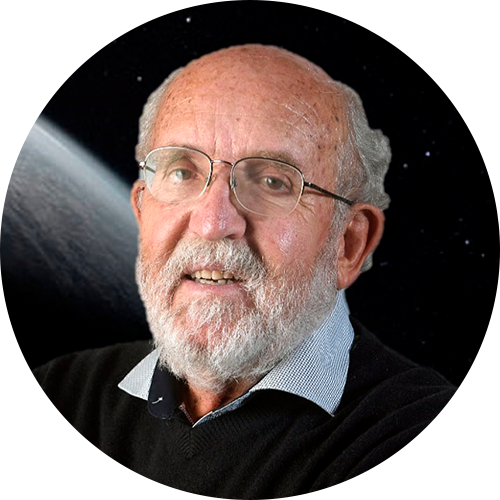PUBLIC LECTURE
Monday 2 August 2021 - 17h30 to 18h30
Michel Mayor
(University of Geneva)
2019 Nobel Prize in Physics

Michel Mayor was born in Lausanne (Switzerland). Having obtained a master in physics at Lausanne University, he moved to astrophysics and get interested in the dynamics of spiral galaxies.
The PhD of Michel Mayor was devoted to the search of evidence of spiral structure in the Milky Way in the velocity distribution of stars close to the Sun. To test that possibility, at the end of his PhD he decided to develop a new specific spectrograph to measure stellar radial velocities. This was the start of his interest in stellar kinematics. This research led to various fields of interest, among which the dynamics of globular clusters and the study of statistical characteristics of solar-type binary stars (Duquennoy, Mayor, 1991). He was naturally driven to study small mass companions to stars analogous to our Sun. By the end of the 1980’s the evolution of technology was such to allow for the development of a new spectrograph. This spectrograph, built at the Haute-Provence Observatory, reached a level of precision permitting to detect extra-solar planets.
Part of a large survey, with Didier Queloz, one of his graduate students, they have detected, in 1995, the planetary companion to the solar-type star 51 Pegasi: this was the first detection of an exoplanet. This discovery has resulted in the advent of an exciting new research field “exoplanets”. As a result of constant improvements to his high dispersion spectrographs Mayor’s work has significantly contributed to the discovery of “super-Earth” planets with mass greater than that of Earth.
In 2000, Michel Mayor took the lead for the construction of a new spectrograph: HARPS, optimized to search for very low mass planets. This spectrograph revealed the large occurrence of the subpopulation of super-Earths on tight orbits, challenging the scenarios of planetary formation. Apart from his research activity, Michel Mayor initiates a series of advanced level courses of Astrophysics since 1971, the “Saas-Fee courses”. He was a co-organizer for nine of these courses. From 1984 to 2007, he was teaching astrophysics at Geneva University for undergraduate courses at the department of physics as well as post-graduate ones at the department of astronomy. From 1998 to 2004, Michel Mayor was Director of the Geneva Observatory. He was also active in ESO (the European Southern Observatory), being the Chairman of the Scientific and Technological Committee of that organization (1990-92) and the Swiss delegate to the Council of ESO (2003-2007).
In the frame of the IAU (International Astronomical Union) Michel Mayor chaired the Commission on the “Structure and Dynamics of the Galactic System” (1988-1991), as well as the new Commission devoted to “Extra-solar planets” (2006-2009).
Twenty years after the discovery of 51Peg b, Michel Mayor is still very active to detect and characterize exoplanets, devoting a large fraction of his time as a member of his group of research as well as inspiring other teams. For example, Michel Mayor was at the origin (with D. Latham) of the development of a northern copy of the overwhelming HARPS spectrograph to measure the mass of rocky planets detected by the Kepler space mission. A program focused on the physics of very low mass planets having allowed numerous scientific publications. He also gives a large tribute to outreach activities … a direct consequence of the exceptional interest of the public for that new domain of astronomy.
Since 2007, Michel Mayor is Emeritus Professor at Geneva University. He has been jointly awarded the 2019 Nobel Prize in Physics along with Professor James Peebles and Professor Didier Queloz.
Biography text and image: University of Geneva
